BABAR and Belle II
The flavour physics group is involved in the BaBar Experiment at SLAC and the Belle II Experiment at KEK in Japan.
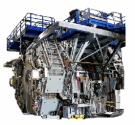
BABAR: The BaBar experiment is designed to study how the laws of physics differ for ordinary matter and anti-matter. It was believed until 1964 that the laws of physics were the identical for matter and anti-matter; more technically, that all interactions were invariant under the combined symmetry operation CP (C=charge conjugation, P=parity). This belief was shattered in a famous experiment by Cronin and Fitch, in which it was shown that CP was violated at a part per thousand in the neutral K meson system. For the next 35 years we had been unable to measure CP violation in any other system, making it impossible to test the theory describing this phenomena.
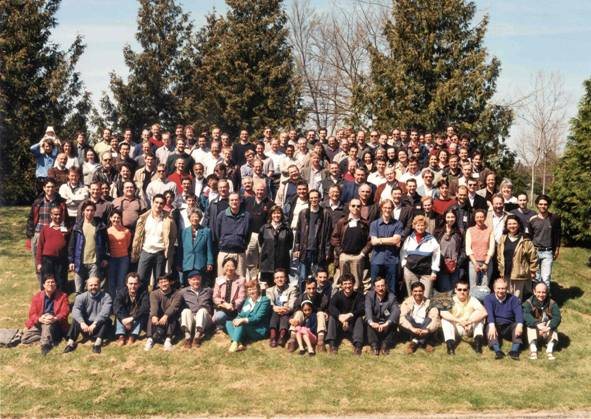 BaBar recorded its first e+e- collision data in May, 1999 and as of October, 2003 has accumulated over 120 million B-Bbar events. The performance of the PEP-II accelerator has been excellent, reaching the design luminosity in the first full year of operation and exceeding design by more than a factor of two. BaBar published the first definitive observation that CP is violated in B meson decays in July, 2001: "Observation of CP violation in the B0 meson System", PRL 87, 091801 (2001). BaBar met in Victoria for its May 2002 Collaboration Meeting, where the picture above was taken.
BaBar recorded its first e+e- collision data in May, 1999 and as of October, 2003 has accumulated over 120 million B-Bbar events. The performance of the PEP-II accelerator has been excellent, reaching the design luminosity in the first full year of operation and exceeding design by more than a factor of two. BaBar published the first definitive observation that CP is violated in B meson decays in July, 2001: "Observation of CP violation in the B0 meson System", PRL 87, 091801 (2001). BaBar met in Victoria for its May 2002 Collaboration Meeting, where the picture above was taken.
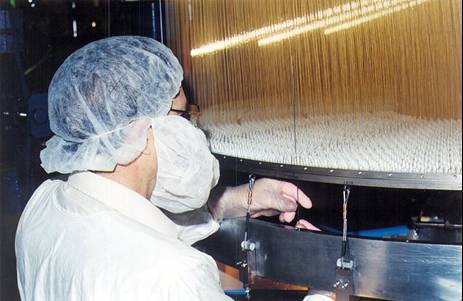 VISPA has an active group on BaBar with faculty members Justin Albert, Robert Kolwalewski, Michael Roney and Randall Sobie. We collaborated with Canadian, Italian, and U.S. institutions on the construction and quality control of the BaBar drift chamber. The drift chamber, the primary BaBar detector for measuring charged particle trajectories, was built at TRIUMF and was installed in the BaBar experiment during 1998. The chamber provides the primary momentum measurement and ionization energy loss (dE/dx) measurement for charged particles in BaBar.
VISPA has an active group on BaBar with faculty members Justin Albert, Robert Kolwalewski, Michael Roney and Randall Sobie. We collaborated with Canadian, Italian, and U.S. institutions on the construction and quality control of the BaBar drift chamber. The drift chamber, the primary BaBar detector for measuring charged particle trajectories, was built at TRIUMF and was installed in the BaBar experiment during 1998. The chamber provides the primary momentum measurement and ionization energy loss (dE/dx) measurement for charged particles in BaBar.
The focus of our effort is now on analyzing BaBar data and producing physics results. Our group contributes heavily in the analysis of semileptonic B meson decays and in studies of the tau lepton, where members of our group are convenors of BaBar-wide analysis working groups. We have significant computing resources in Victoria (two Linux clusters and tens of terabytes of storage) that are used for data analysis and for producing simulated event samples for use by the BaBar collaboration.
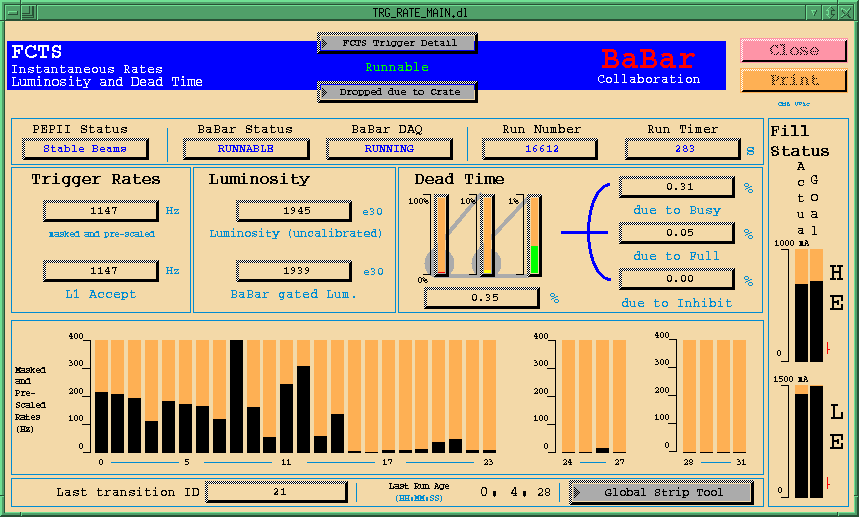 Victoria has contributed to the online control software (written in EPICS), the operation of the Drift chamber gas system, the tracking reconstruction software, the dE/dx calibration and central data analysis software. Members of our group have served as Run Manager (in charge of daily BaBar data taking operations) and as members of the Executive Board and the Publications Board. The current leader of the BaBar collaboration, its Spokesperson, is University of Victoria professor Michael Roney.
Victoria has contributed to the online control software (written in EPICS), the operation of the Drift chamber gas system, the tracking reconstruction software, the dE/dx calibration and central data analysis software. Members of our group have served as Run Manager (in charge of daily BaBar data taking operations) and as members of the Executive Board and the Publications Board. The current leader of the BaBar collaboration, its Spokesperson, is University of Victoria professor Michael Roney.
BaBar will continue to publish cutting-edge results for several more years.
Belle II: Looking to the future, Victoria is now a driver in the Canadian effort on Belle-II, the next generation 10.58GeV electron-positron collider project at the KEK laboratory in Japan designed to search for new physics at the precision frontier with 40 times the intensity available to Belle and BaBar, the present generation experiments. VISPA has faculty members Robert Kolwalewski, Michael Roney and Randall Sobie on Belle II.
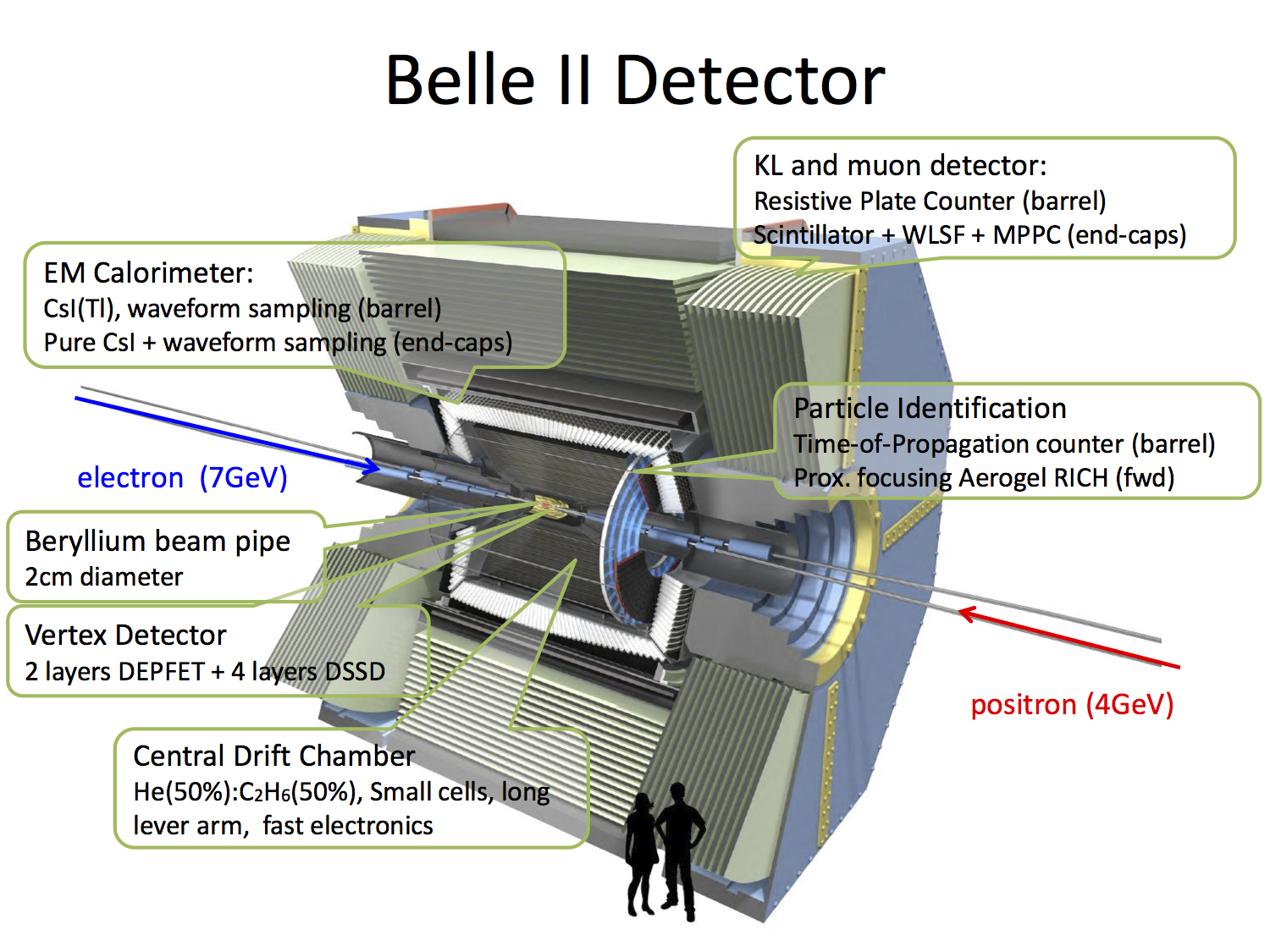 The Belle-II experiment will look for evidence of new physics at the precision frontier in electron-positron collisions at a centre-of-mass energy of 10.58 GeV. It will operate at SuperKEKB, which is an upgrade of the 3.0km circumference electron-positron collider at the KEK laboratory in Tsukuba, Japan. It is designed to achieve a world-record collider luminosity of 8x1035cm-2s-1. Construction is on schedule for a physics start in late 2016. The centre-of-mass energy is selected to be just above the threshold for producing particles containing the b-quark (B-mesons) and will also produce events containing pairs of tau leptons as well as events with particles containing the charm quark. This facility will produce 30 times the world’s total existing data sample of these processes. With this sample, Belle-II will the probe flavour sector of subatomic physics by searching for rare processes and making precision measurements.
The Belle-II experiment will look for evidence of new physics at the precision frontier in electron-positron collisions at a centre-of-mass energy of 10.58 GeV. It will operate at SuperKEKB, which is an upgrade of the 3.0km circumference electron-positron collider at the KEK laboratory in Tsukuba, Japan. It is designed to achieve a world-record collider luminosity of 8x1035cm-2s-1. Construction is on schedule for a physics start in late 2016. The centre-of-mass energy is selected to be just above the threshold for producing particles containing the b-quark (B-mesons) and will also produce events containing pairs of tau leptons as well as events with particles containing the charm quark. This facility will produce 30 times the world’s total existing data sample of these processes. With this sample, Belle-II will the probe flavour sector of subatomic physics by searching for rare processes and making precision measurements.
Such a precision frontier facility opens an exciting window on new energy scales beyond the reach of existing colliders, including CERN's Large Hadron Collider (LHC), and will help explain any new physics that might be discovered at LHC, by virtue of quantum loop corrections which are sensitive to very massive, and as yet undiscovered, particles. These hypothesized particles manifest themselves in precision measurements of rare processes. They also reveal themselves via the presence of processes that are forbidden within our current understanding of physics. Belle-II will make measurements of CP violation and the CKM quark mixing matrix elements with unprecedented precision in order to search for deviations from the Standard Model and will be the most sensitive experiment to search for lepton flavour violation in tau decays. A wide variety of other precision frontier measurements with B mesons, charm, tau, radiative return events, and two-photon physics will also be carried out.
The Canadian Belle II team is preparing for the commissioning and data collection of Belle II and is completing research and development on the possible upgrade of the Belle II forward endcap calorimeter. The latter includes conducting test beam experiments to determine the impact of the high radiation environment at SuperKEKB on the endcap calorimeter performance. The Canadian group is contributing to the ECL reconstruction software development, calibration, feature extraction, and commissioning of the Belle II electromagnetic calorimeter and is developing fast electronics for a possible calorimeter upgrade. It is responsible for the accelerator background and shielding studies related to the calorimeter. During the commissioning phases of the accelerator the group will provide measurements of the thermal neutron flux and photon flux at the position of the inner radius of the calorimeter. Belle II Canada is also providing the permanent photon background monitoring system, which will be provided to the accelerator team and used to tune the machine. The team also contributes to the development of cloud computing software for Belle II.
Our group welcomes applications from prospective graduate students at the M.Sc. and Ph.D. level.
The VISPA Belle II team
Faculty and Adjunct Faculty
Research Personnel
- Dr. Frank Berghaus (Cloud Developer)
- Paul Birney (TRIUMF)
- Mark Lenkowski (TRIUMF)
- Dr. Paul Poffenberger (VISPA)
Graduate Students
- Sam De Jong
- Alex Beaulieu
- Savino Longo
The VISPA BaBar team
Faculty and Adjunct Faculty
Research Personnel
- Dr. Frank Berghaus (Cloud Developer)
Graduate Students
- Greg King
- Nafisa Tasneem
